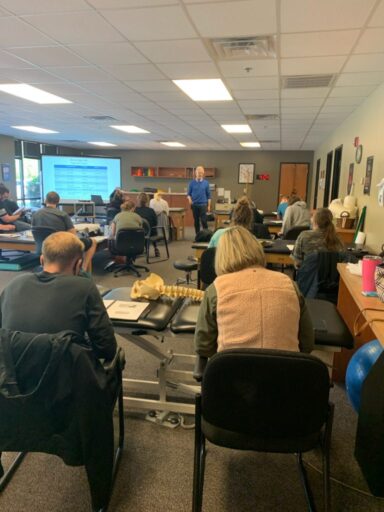COMT Program
Did you know that there are 220,000 physical therapists in this country and less than 1% are trained to the highest skill level as Manual Therapists? If you are interested in pursuing the highest level of manual therapy skill available, this is the place. STAR now has in place a Certificate of Manual Therapy program.
The primary instructor in this program is David Sheer, DPT, MOMT, FAAOMPT. David has over 40 years of experience in manual therapy and over 30 years of experience in teaching and mentoring clinicians for their Fellowships, Master, and Doctorate degrees. He is also a Founding Fellow of the American Academy of Orthopedic Manual Therapy.
This program is a 2-year program comprised of 8 courses that are approved by the TPTA. Completion of the program will allow clinicians to apply for entry to Fellowship in Manual Therapy programs.
These 8 courses provide an up-to-date knowledge base in a wide range of areas needed to comprehensively treat patients in need of manual therapy with clinical rationale from a cellular level to the neurological level. Clinicians will walk away from each course with a sense of personal and professional satisfaction.
Each course is followed by a 2 ½ hour workshop to review rationale, cases, and techniques. Each clinician will also be seen, at their location, by a mentor, with a patient of their choosing. Our mentors are also available at any time to review cases in person, by email, or by phone.
The program is comprehensive, challenging, and very rewarding.
STAR Physical Therapy is committed to being the industry leader in continuing education, which is why we offer a diverse continuing education calendar each year for our clinicians.


COMT Tract Courses
1. Intro to Becoming a Multi-Modal Manual Therapist
This course introduces musculoskeletal tissue diagnosis within a complex framework of associated influences including psychology, sociology, brain science, pain science, nutrition, and visceral factors. The basis of manual therapy remains a complete musculoskeletal evaluation as a means of integrating the impact of the other factors, arriving at a tissue sensitivity that makes sense to treat.
2. Examination and Treatment of the Lumbar and Sacral Complex
This course details a practical examination and treatment of the lumbar spine, sacroiliac joint, pubic, and coccyx. It first reviews the practical regional anatomy. It then moves to the exam procedure designed to assist the clinician in developing a working tissue diagnosis.
3. Examination and Treatment of the Cervical and Thoracic Spine
This course details practical examination and treatment from the occiput to the upper thoracic region. It first reviews the practical regional anatomy and biomechanics. It then moves to the exam procedure designed to assist the clinician in developing a working tissue diagnosis.
4. Examination and Treatment of the Upper Extremity
This course is designed to facilitate the clinical reasoning process and arrive at a musculoskeletal tissue diagnosis for the upper quarter. It will discuss the management of common conditions such as impingement, instability, capsulitis, and tendinopathy. It will integrate the concept of regional interdependence with the spine and proximal/distal joints.
5. Examination and Treatment of the Lower Extremity
This course provides a functional assessment and manual exam of the hip, knee, and ankle using clinical reasoning. It is based on a tissue diagnosis approach. Integrated into this are regional influences from the spine and opposite lower extremity. Common pathologies are considered for each region including the labrum, capsule, joint surfaces, nerves, and muscle tendon.
6. Exercise Rationale: Protocol for Dosage and Progression
This course introduces the clinician to concept of exercise as medicine. Each musculoskeletal injury requires the correct dosage of exercise to facilitate healing of the damaged tissue. Ligament, muscle, cartilage, and discs all require appropriate stimulation through exercise to create optimal repair.
7. Connective Tissue Techniques and Taping
This course examines and treats the connective tissue elements of the spinal and peripheral neuromusculoskeletal system. Common conditions include acute and chronic muscle guarding, tendinopathies, and myofascial syndromes. Neurologic and mechanical rationale for taping is provided.
8. Screening Co-Morbidities
In our rapidly evolving direct access environment, clinicians will often be faced with patients presenting with symptoms referred from non musculoskeletal sources. We answer the questions: When to treat? When to treat with concurrent comorbidities? and when to refer back to the MD?


David Sheer, DPT, MOMT, FAAOMPT, has been a practicing clinician for 42 years. He has specialized in manual therapy for the last 32 years earning a Masters’ Degree in Orthopedic Manual Therapy and a Doctorate in Physical Therapy. He is a Founding Fellow in the AAOMPT. David has taught a variety of courses in manual therapy, including clinical rationale, spinal and extremity techniques, exercise, nutrition, and the neuroscience of pain. These courses include extensive psychomotor training. David has been a clinical instructor for Belmont University and The University of Tennessee Health Science Center, has trained therapists in Masters’ Degree Residency programs, and has created and taught Certificate of Manual Therapy curriculums. David is currently an independent clinical educator in Tennessee.
